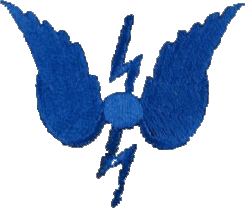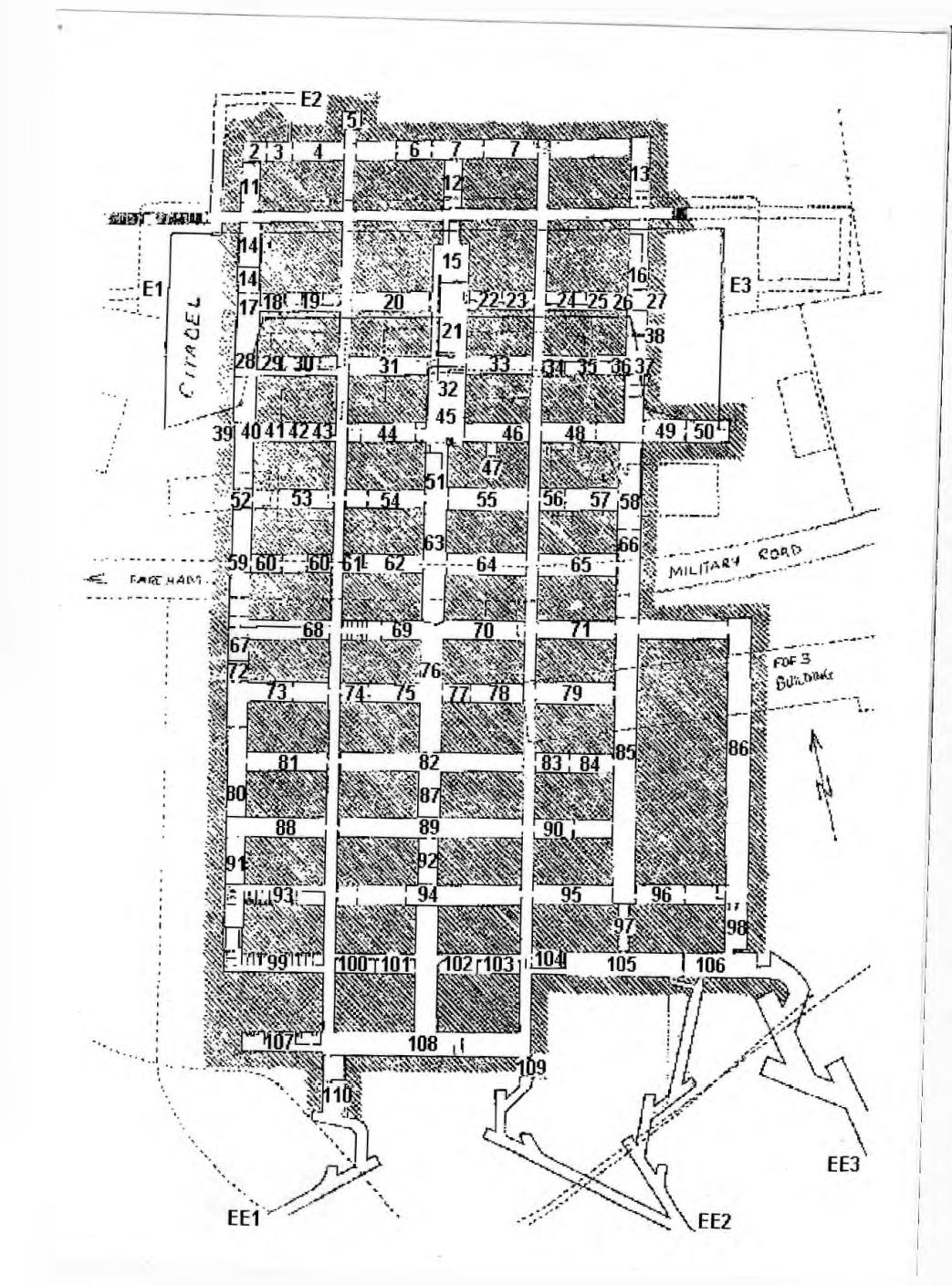


The History of Fort Southwick & the Undergound Headquarters
World War II to Present Date
Introduction
Fort Southwick was built in the mid 19th century to repel a perceived threatened invasion by France. The main armaments are all directed overland to counter an invasion from further along the coast which would be followed by an overland march to secure Portsmouth. Portsmouth harbour was considered secure from seaward by the harbour and Solent forts.
The Forts were the brainchild of Lord Palmerston and, because the threatened invasion decreased to being negligible before the forts were finished, they became known as Palmerston's Follies of which Fort Southwick is one.
The forts were constructed by mainly Irish and Welsh labour and built from Fareham Brick. Brick was a thriving industry in Fareham (Kiln Road), well serviced by the then busy port (Quay Street). It is believed that Lord Palmerston had a major interest in the local brick works so perhaps he didn't mind at all hat the forts were dubbed follies.
As a matter of interest, as the forts were completed much of the labour and brick output was conveniently transferred to digging (Welsh miners) and bricking (Irish labour) the two large railway tunnels tha run in the vicinity of Highlands Road and Funtley (Miners Arms at Funtley).
1. The Fort & the Underground Headquarters.
2. The Headquarters Reserve Unit RNR - HMS SOUTHWICK.
3. Events leading to the closure of the Underground Headquarters.
4. Summary of events.
Appendix: Layout of the Underground Headquarters.
1. FORT SOUTHWICK AND THE UNDERGROUND HEADQUARTERS.
During World War II the Fort Southwick Underground Headquarters (UGHQ) was excavated by Welsh and Belgian miners of the Pioneer Corps, who were quartered in the upper Fort.
The UGHQ (completed 1942) and known as Portsmouth Naval Headquartes, was designed as a conventional bombproof HQ for war time use by the Commander-in-Chief Portsmouth. The headquarters contained a comprehensive naval operational control centre with associated communication capability and limited accommodation facilities. It was no, as is often stated, the headquarter of the Allied Commander-in-Chief 'D' Day Expeditionary Force, which was in fact at Southwick House (HMS DRYAD). The Allied Naval Commander did, however, make full use of the UGHQ communication facilities for Operation 'OVERLORD' from his office at Southwick House.
LAYOUT: Three main tunnels running parallel to each other with twelve cross passages provided office space, limited victualling facilities and some cabin and dormitory accommodation. In addition, two other tunnels and one cross passage were used as gangways and for emergency off-watch bunk sleeping. The depth of the UGHQ varied according to the slop of the hill but was in the region of 80 - 100 feet.
ENTRANCES: There were two main entrances/exits. The eastern (179 steps) entrance was alongside the present CINCNAVHOME (CNH) Plans Division Offices, whilst the Southern entrance, known as the South Adit was on the slope overlooking the harbour. Four other entrances, namely the Galley Tunnel (Northwest Stairs), the West Stairs, the Diesel Tunnel and the Air Supply Tunnel could be opened for emergency evacuation.
VENTILATION: Air conditioning was provided through anti-gas filters and the system could, if necessary, be operated as a closed recirculation circuit.
FRESH WATER SUPPLY: 2 X 2,000 gallon tanks were provided for the exclusive use of the UGHQ.
COMPLEMENT: The War Complement, including the above-ground staff, was in the region of 140 Officers and 480 ratings.
ACCOMMODATION: Under normal conditions ample above-ground sleeping and living accommodation was provided. officer sleeping accommodation was, in the main, provided by using caravans parked in the moat. During a state of 'alert' however the under-ground victualling and accommodation facilities were activated. The cabins and dormitories, together with the bunks along the passage tunnels were used for off-watch sleeping - i.e. in a 2 watch organisation.
At the end of World War II the upper Fort was, for a period (1946-1948) used by the Signal School (HMS MERCURY) for the training of Communication Branch National Service and Short Service ratings. The UGHQ was however sealed off, the intention being that it should remain dormant ready for any future emergency. On completion of the Signal School task the upper Fort was placed under the jurisdiction of the Captain, HMS DRYAD and manned, on a care and maintenance basis, by an RN Officer and a small civilian staff.
During the 1950s (i.e. between the Korean War (1950-1952) and the Suez Crisis (1956) the Commander-in-Chief Portsmouth, who on 21 February 1952 was appointed to the NATO post of Commander-in-Chief Channel (CINCHAN), decided that to meet his National and NATO responsibilities he would require a Headquarters which could provide better facilities than those available in HM Dockyard. The answer was - back to the Fort Southwick UGHQ - in the meantime however, it was discovered that the UGHQ had bee broke into through the south adit and considerable damage incurred by local vandals. Navy Works were consulted to provide estimates to meet the cost of the re-activation of the UGHQ. The resultant figures were 'in the light of the current financial climate' out of the question, and in consequence an RN working party (1 Chief Shipt, 2 Shipts, 1 CERA, 1 Mech and 2 Stokers) were put to work to return the UGHQ to a state of readiness. This project was completed in about twelve months. Later, during the Suez Crisis (1956), money was found and the entire UGHQ was refurbished to an operational state. It was during this latter period (1956 - 1960) that the Fort and UGHQ were activated for exercise periods, with all facilities being made available. The offices being used for exercise planning and subsequent analysis.
Pressure for office space, particularly for the Ship's Maintenance Authority and Fleet Technical Staff, and the unsatisfactory nature of a part-time HQ for CINCHAN and CINCHOME with the increasing NATO exercise cycle caused the willing move of CINCHAN/HOME (Desig) Staffs to the Fort on a permanent basic.
2. THE HEADQUARTERS RESERVE UNIT ROYAL NAVAL RESERVES
In 1958 the Portsmouth Headquarters Reserve Unit was commissioned - the sequence of events being as follows:-
1. The Fort & the Underground Headquarters. 2. The Headquarters Reserve Unit RNR - HMS SOUTHWICK. 3. Events leading to the closure of the Underground Headquarters. 4. Summary of events. Appendix: Layout of the Underground Headquarters.
1. FORT SOUTHWICK AND THE UNDERGROUND HEADQUARTERS.
During World War II the Fort Southwick Underground Headquarters (UGHQ) was excavated by Welsh and Belgian miners of the Pioneer Corps, who were quartered in the upper Fort. The UGHQ (completed 1942) and known as Portsmouth Naval Headquartes, was designed as a conventional bombproof HQ for war time use by the Commander-in-Chief Portsmouth. The headquarters contained a comprehensive naval operational control centre with associated communication capability and limited accommodation facilities. It was no, as is often stated, the headquarter of the Allied Commander-in-Chief 'D' Day Expeditionary Force, which was in fact at Southwick House (HMS DRYAD). The Allied Naval Commander did, however, make full use of the UGHQ communication facilities for Operation 'OVERLORD' from his office at Southwick House.
LAYOUT: Three main tunnels running parallel to each other with twelve cross passages provided office space, limited victualling facilities and some cabin and dormitory accommodation. In addition, two other tunnels and one cross passage were used as gangways and for emergency off-watch bunk sleeping. The depth of the UGHQ varied according to the slop of the hill but was in the region of 80 - 100 feet.
ENTRANCES: There were two main entrances/exits. The eastern (179 steps) entrance was alongside the present CINCNAVHOME (CNH) Plans Division Offices, whilst the Southern entrance, known as the South Adit was on the slope overlooking the harbour. Four other entrances, namely the Galley Tunnel (Northwest Stairs), the West Stairs, the Diesel Tunnel and the Air Supply Tunnel could be opened for emergency evacuation.
VENTILATION: Air conditioning was provided through anti-gas filters and the system could, if necessary, be operated as a closed recirculation circuit.
FRESH WATER SUPPLY: 2 X 2,000 gallon tanks were provided for the exclusive use of the UGHQ.
COMPLEMENT: The War Complement, including the above-ground staff, was in the region of 140 Officers and 480 ratings.
ACCOMMODATION: Under normal conditions ample above-ground sleeping and living accommodation was provided. officer sleeping accommodation was, in the main, provided by using caravans parked in the moat. During a state of 'alert' however the under-ground victualling and accommodation facilities were activated. The cabins and dormitories, together with the bunks along the passage tunnels were used for off-watch sleeping - i.e. in a 2 watch organisation.
At the end of World War II the upper Fort was, for a period (1946-1948) used by the Signal School (HMS MERCURY) for the training of Communication Branch National Service and Short Service ratings. The UGHQ was however sealed off, the intention being that it should remain dormant ready for any future emergency. On completion of the Signal School task the upper Fort was placed under the jurisdiction of the Captain, HMS DRYAD and manned, on a care and maintenance basis, by an RN Officer and a small civilian staff.
During the 1950s (i.e. between the Korean War (1950-1952) and the Suez Crisis (1956) the Commander-in-Chief Portsmouth, who on 21 February 1952 was appointed to the NATO post of Commander-in-Chief Channel (CINCHAN), decided that to meet his National and NATO responsibilities he would require a Headquarters which could provide better facilities than those available in HM Dockyard. The answer was - back to the Fort Southwick UGHQ - in the meantime however, it was discovered that the UGHQ had bee broke into through the south adit and considerable damage incurred by local vandals. Navy Works were consulted to provide estimates to meet the cost of the re-activation of the UGHQ. The resultant figures were 'in the light of the current financial climate' out of the question, and in consequence an RN working party (1 Chief Shipt, 2 Shipts, 1 CERA, 1 Mech and 2 Stokers) were put to work to return the UGHQ to a state of readiness. This project was completed in about twelve months. Later, during the Suez Crisis (1956), money was found and the entire UGHQ was refurbished to an operational state. It was during this latter period (1956 - 1960) that the Fort and UGHQ were activated for exercise periods, with all facilities being made available. The offices being used for exercise planning and subsequent analysis.
Pressure for office space, particularly for the Ship's Maintenance Authority and Fleet Technical Staff, and the unsatisfactory nature of a part-time HQ for CINCHAN and CINCHOME with the increasing NATO exercise cycle caused the willing move of CINCHAN/HOME (Desig) Staffs to the Fort on a permanent basic.
2. THE HEADQUARTERS RESERVE UNIT ROYAL NAVAL RESERVES
In 1958 the Portsmouth Headquarters Reserve Unit was commissioned - the sequence of events being as follows:-
| 11 June 1958 | Unit commissioned in HMS VICTORY (RNB); the plan was that training would be carried out a. for Plotters in the Royal Naval Barracks b. for Communicators in the Main Signal Office and Command Typing School in HM Dockyard. Unit administration would be dealt with at the offices of CinC Portsmouth in HM Dockyard. | |
| September 1958 | Exercise FALLEX 58 (the 'SHIPSHAPE' Series) at Fort Southwick, on completion of which the HQ Reserve Unit training was transferred to the Fort whilst the administrative function remained in CinC Portsmouth Offices. | |
| April 1959 | The ship name HMS SOUTHWICK allocated to the HQ Unit. | |
| May 1960 | Unit administration tranferred to Fort Southwick. |
3. EVENTS LEADING TO THE CLOSURE OF THE UGHQ
During 1968/69 after the move of CINCHAN to Northwood, and in the light of the proposed new Naval Home Command Organisation, it became evident that the UGHQ was too big and required modernisation. Whereas the operational plotting layout was no longer applicable to the proposed CINCNAVHOME task, the communication equipment was long overdue for updating. Another factor was the problem with water seepage - the tunnels were becoming extremely damp, indeed the initial fit of 'online' communication equipment emphasised the fact that to fit expensive electrical equipment in damp underground tunnels would be extremely imprudent. A further consideration was that, after investigation of a serious fire in a Royal Air Force underground site, the Ministry of Defence fir authorities submitted a report that our UGHQ was a fire hazard. Finally the decision to build a new above-ground COMMCEN and close the UGHQ was mad when it became clear that th cost of fully modernising the underground was out of the question on financial grounds.
4. SUMMARY OF EVENTS
| Pre World War II | Fort Southwick occupied by the Army | |
| During World War II | Fort Southwick occupied by the Royal Navy. UGHQ excavated and brought into use in 1942 (whilst not fully completed). | |
| September 1945 | UGHQ reduced to a reserve status and closed down. | |
| April 1946 | RNSS Fort Southwick established. | |
| July 1948 | RNSS Fort Southwick closed - the Fort being reduced to a care and maintenance status under the jurisiction of the Captain, HMS DRYAD. | |
| 23 February 1953 | The Commander-in-Chief Portsmouth appointed to the NATO post of Allied Commander Channel (CINCHAN) with Staff Officers, and the Staff of Commander-in-Chief Home (Desig)(incluing Royal Naval Minewatching Service Officers) operating in the old Tactical School in H.M. Dockyard. | |
| 11 June 1958 | Portsmouth HQ Reserve Unit commissioned. | |
| September 1958 | UGHQ temporarily activated for FALLE '58. | |
| May 1960 | Limited communication watchkeeping (0800 - 2000 daily) activated in the UGHQ. This move from the Dockyard MSO was made to facilitate the switching of the Teleprinter Landline Network and to improve Portsmouth Command Coastal Radio Net coverage. | |
| 1962 | CINCHAN and CINCHOME (Desig) Staffs transferred to Fort Southwick. NATO communications switch to UGHQ. UGHQ communication centre fully activated. | |
| November 1962 | Transformation of the Royal Naval Minewatching Service to the Royal Naval Auxiliary Service (RNXS) and the establishment of the post of Captain RNXS. | |
| 21 January 1966 | CINCHAN appointment amalgamated with that of CINCEASTLANT, and in consequence , Channel staff moved to Northwood. Fort Southwick became the Headquarters of CINCHOME (Desig). Shortly after this the Home (Desig) title was changed to CINCNAVHOME (Desig). | |
| 1966 | Shore offices of the Flag Officer Aircraft Carriers (FOAC) established in Fort Southwick later to become Flag Officer Aircraft Carriers and Amphibious Ships (FOCAS) in September 1968, and again in January 1979 to Flag Officer Third Flotilla (FOF3). | |
| 1968 | Plotting facilities to meet CINCNAVHOME requirements transferred to the Upper Fort (the present War Information Room complex). | |
| 1969 | The demise of Commander-in-Chief Portsmouth and CINCNAVHOME (Desig); the latter staff became the Plans and Exercises Division of the revised Naval Home Command. (The Admiral's flag which was flown at Fort Southwick was sruck and the large mast sited immediately in front of the Fort removed). | |
| 1971 | Logistic support of the Fort (and UGHQ) transferred to HMS VICTORY (RNB) from HMS DRYAD. Emergency war victualling stocks removed from the Fort and UGHQ. | |
| January 1972 | Naval Foreign and Commonwealth Training Directorate established in Fort Southwick. | |
| May 1972 | C E D (Tels) Department established in existing semi-permanent accommodation in Fort Southwick. | |
| September 1974 | Fort Southwick above ground Communication Centre commissioned. UGHQ gutted and sealed off. |
| EE1 | Western escape route - filled in | 56 | OPS PBX - Operations Private Branch Exchange | |
| EE2 | Central escape route - filled in | 57 | GPO Relay Set & Frame Room | |
| EE3 | Eastern escape route - still exists | 58 | GPO Battery Room | |
| 1 | Water Tank - this is outside the plan at the top left | 59 | Meteorological Office | |
| 2 | Logistic and ground damage plot | 60 | Spare | |
| 3 | Fire point | 61 | Cleaners Store | |
| 4 | Logistics | 62 | Couriergram Office | |
| 5 | DCHQ No.2 Damage Control HQ | 63 | MSO - Main Signals Office | |
| 6 | Plans | 64 | MSO Records (see 63) | |
| 7 | Intelligence Office | 65 | Admin PBX - Administration - Public Branch Exchange | |
| 11 | Logistics | 66 | GPO Power Room | |
| 12 | Intelligence | 67 | Crypto Store | |
| 13 | Commander in Chief's Communications Records | 68 | Crypto Workshops | |
| 14 | Technical | 69 | TP Room - Teleprinter | |
| 15 | Intelligence | 70 | TP Room - Teleprinter | |
| 16 | Commander in Chief | 71 | Spare | |
| 17 | A/COS(A), A/COS(T) - Assistant Chief of Staff Administration and Assistant Chief of Staff Tactics | 72 | WR Room - Wardroom Store | |
| 18 | Submarine & Naval Liaison Officers | 73 | Wardroom | |
| 19 | Belgian, French & Netherlands national advisors. Flag office Netherlands (GB) | 74 | Tube Exchange & Teleprinter Store | |
| 20 | Records Room (more like coding room) | 75 | TP Room - Teleprinter | |
| 21 | Main Operations Room | 76 | TP Room - Teleprinter | |
| 22 | OPS - Operations Office (reported to be the WT room) | 77 | Tube motors | |
| 23 | SOO - Staff Office Operations | 78 | EEM Sub station - Electrical Enginering Manages (HM Dockyard system) so not off National Grid but supplied by private Generation Station off Main and Victoria Roads in the Portsmouth Dockyard | |
| 24 | COAS -(thought to be Chief of Air Staff but this should be CAS - possibly Chief of Army Staff) | 79 | TP Switchboard - Teleprinter switchboard (private wire network) | |
| 25 | A/COS OPS - Assistant Chief of Staff Operations | 80 | Galley | |
| 26 | SEC COAS - Secretary to COAS (see 24) | 81 | Wardroom | |
| 27 | Flag Lieutenant | 82 | Spare | |
| 28 | Conference Room | 83 | GPO - (General Post Office) | |
| 29 | Marititme Air Liaison Officer | 84 | GPO - (General Post Office) | |
| 30 | Shipping plans | 85 | GPO V/F Room - Voice Frequency Repeater (audio amplifiers) | |
| 31 | Trade Records | 86 | GPO Carrier Room | |
| 32 | Trade plot | 87 | EEM Store - see 78 above store for spare parts, cable etc | |
| 33 | National Shipping Authority & Military Movements | 88 | Spare | |
| 34 | A/COS plans. Assistant Chief of Staff Plans | 89 | Ratings Mess | |
| 35 | COS - Chief of Staff [normally a Rear Admiral and 2nd in command] | 90 | Dormitory | |
| 36 | SEC COS - Secretary to Chief of Staff (see 35) | 91 | Galley Store | |
| 37 | Channel committee secretariat | 92 | Dormitory | |
| 38 | Secretary | 93 | Officers Lavatories | |
| 39 | Spare | 94 | Dormitory | |
| 40 | SOMW - Senior Officer Mine Warfare | 95 | Dormitory | |
| 41 | SONCS (CH)) - Senior Officer Naval Control Service | 96 | GPO - (General Post Office) | |
| 42 | SONCS (H) Senior Officer Naval Control Service | 97 | Secondary Lighting Batteries | |
| 43 | A/COS trade - Assistant to Chief of Staff (with responsibility for Trade (Mercantile Marine) - see 25) | 98 | AC Room - Air Conditioning Room | |
| 44 | Q Message Room - may be referring to 'Q' (or deception i.e. Operation Fortitude) messages. This was one of the duties of the EXTRA rooms and tunnels below parts of the Western Heights Dover | 99 | Ratings Lavatories | |
| 45 | Minew Warfare Plot | 100 | Engineers Workshop | |
| 46 | Mine Records | 101 | Engineers Store | |
| 47 | Clock control Update 02-01-2010. The small clock room had racks in it that were full of glass tubes with the small ships in for the map room (source Andy Stevens) | 102 | Boiler Room | |
| 48 | Office 2 | 103 | DCHQ No1 (Damage Contol) | |
| 49 | Typing Pool | 104 | Coke Hold | |
| 50 | Top Secretary Registry | 105 | Diesels | |
| 51 | CSO - Command Signals Officer | 106 | Coolers | |
| 52 | Fire Point | 107 | Ladies Lavatories | |
| 53 | Netherlands Crypto Office | 108 | Air conditioning plant | |
| 54 | Crypto Office | 109 | Police keyboard | |
| 55 | WT Office - Wireless Telegraphy | 110 | 'B' adit an intake tunnel |
